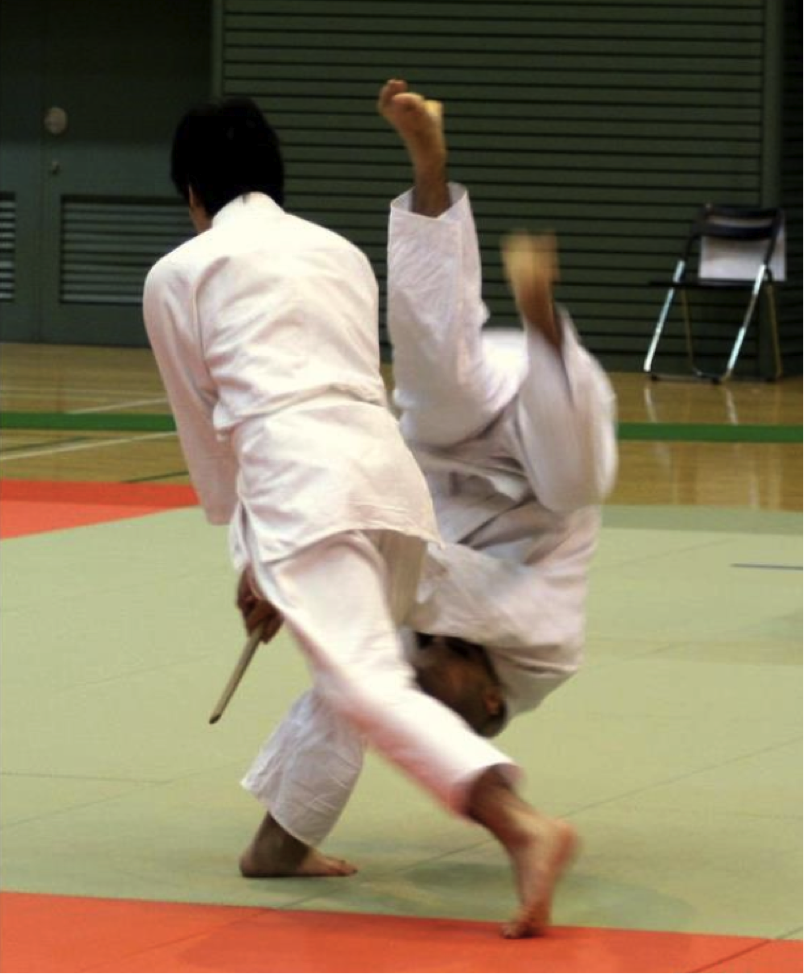
By Benjamin Boas
Mou ikkai! Do it again!
Punching someone properly is an incredibly difficult thing to do. It was not enough to simply drive my fist forward and connect with the target. No, when selected to play the role of the model attacker for the Aikido training of a Japanese police officer, this is nowhere near sufficient. Hips must be aligned with shoulders. The wrist must only extend at the peak of the strike. And I must always, without fail, put my full weight into the punch, driving my front knee forward, as if it is the last punch I will ever make. “Chigau! Chigau!” my teacher screamed. Wrong, wrong!
Everything I was doing was wrong. I had to focus every fiber of my being on what the Fieldman, the head teacher, was saying to me. In all things his word was final; in all things he was right. “What you are throwing is not a punch,” he said as he towered over me. I knelt obediently on my knees. “What you are throwing is shit!” I planted my face into the mat of the Tokyo dojo in apology.
This was yet another day in the 11-month senshusei (専修生) course, the professional instructor training course of the Yoshinkan Aikido Hombu Dojo (養神館合気道本部道場), known to be one of the hardest martial arts courses in the world. Participants are taken from the absolute basics to a black belt and instructor certification in less than a year. The process to become a black belt in most martial arts normally takes several years of training. Yoshinka Akido typically takes four. But the full-time senshusei course is not normal. Training like the live-in dojo students of a foregone age, we braved 8 hours of exhaustion and injury day-in and day-out. My day as a punching model ended like many days did, running around the mats with a rag in one hand and disinfectant in the other. I cleaned the blood that had spattered out of my knuckles, rubbed raw from hundreds of full-contact punches. Far from thinking about the pain, my only concern was that if I did not work fast enough the Fieldman or his assistants would see the red spots and yell at me for having carelessly sullied the mats yet again.
If you had asked me anytime before 2011 if I would consider joining a program like senshusei, I would have laughed. Me? The computer nerd who only started studying Japanese in high school because he wanted to play the video games and read the comics that hadn’t come out in America? The self-confessed “otaku” who spent whole days in the giant video arcades in Japan hunched over a screen? Prior to Yoshinkan I had never set foot in a dojo, let alone thought I would one day be a certified instructor. In fact, I had pretty much given up on myself athletically.
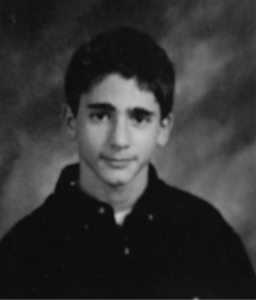
Secondary school for me was an all around horrible time of life. I spent more than half of school involved with junior varsity level athletics, but never achieved any level of success. When I think back to these times, I mainly recall struggling to keep up with stronger classmates, most of whom had a year of puberty on me. It’s easy to realize in retrospect how much of a difference one year of growth can make in athletic ability but I couldn’t fully comprehend this as an 12-year-old preparing to start 8th grade. What I could comprehend was that I needed to pick a sport. Afraid of the beating I would receive were I to pick football, I chose wrestling, where at least only one person could beat on me at a time.
Junior high school wrestling was not too bad. I had a wonderful wrestling coach in 8th grade named Scott Schulte who encouraged me to never let myself down. The only athletic figure in my teenage years to ever take me seriously, Coach Schulte was one of my favorite memories of that year, often letting us take breaks from practice as he told us anecdotes from his side business installing stereo equipment for Japanese clients (“You must unprug machine!”). At the time, my only athletic successes in life had come from using my Nintendo controller to propel an 8-bit avatar to victory in the many video games that cluttered my room, so I always enjoyed hearing Coach’s stories. Unfortunately, I remained as inept at the end of the year as when I started, and Coach Schulte left the school soon after.
The rest of my coaches for junior high and high school sports – cross country, track and field, and wrestling—were not as supportive. Some tried to help me as I flailed around with a javelin or discus, but most gave up quickly. Many were content to simply watch me run clumsily about.
My first high school wrestling coach was a good man who simply didn’t know what to do with someone as uncoordinated as my 98-pound weakling self. While he had worked with improving athletes before, it was as if I was the first specimen of a completely talentless teenager he had ever seen. I enjoyed the wrestling itself and can still remember techniques after not having done them for close to 15 years, but nothing I ever did was right and most of it was so wrong it didn’t even merit a comment from him. When I attempted to replicate the moves he had just demonstrated, he would watch from the side and just kind of shake his head.
The one time I remember him actually correcting me is during the last day of practice in 10th grade. We were going over one of the fundamental techniques in high-school wrestling: the one-handed takedown. This was one of the first moves a young wrestler learns and I had known how to do it for almost two and a half years at that point. Of course, like all of the other moves, I still couldn’t do it right. I remember being told to do the move again and doing it wrong— and then being told to do it again and losing my balance and falling. The coach then turned to me and said, “Ok, Ben. Last chance. This is your absolute last chance to get something right before the end of the year. Now do it right!” I took a deep breath, focused, and looked my partner straight in the eye, prepared to do it right and show the coach I was capable of doing at least one basic move.
I did it wrong.
This wasn’t the worst part. The worst part was the coach’s reaction. Instead of consoling an obviously miserable me or even getting angry, he said, “Well, I guess that’s that,” and walked off. That was the last wrestling practice I ever attended. This was also the moment that I remember more than anything else from my teenage brush with athletics: me failing and the coach walking away. I didn’t even merit a correction because I was just that bad.
While my failures with the wrestling team were probably the latent trigger for my interest in martial arts, it’s my memories of the running teams I was on that were most painful.
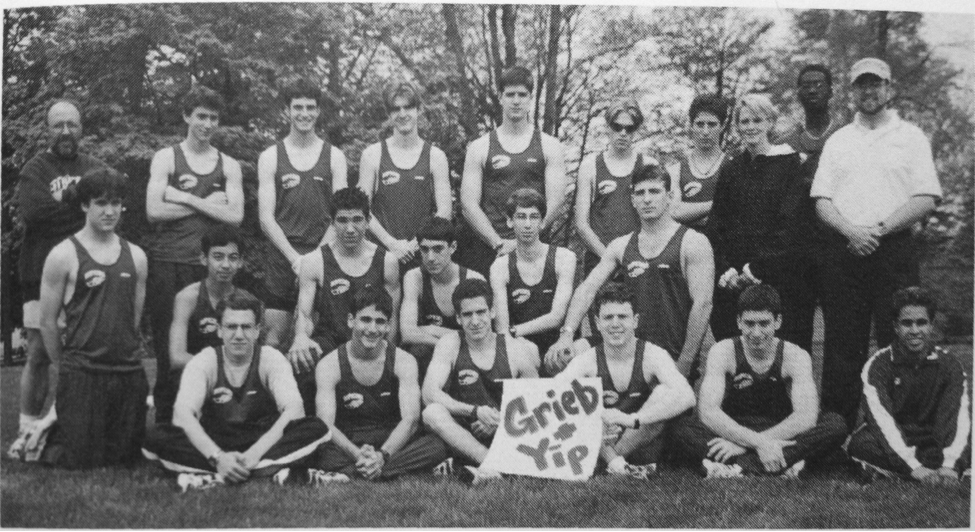
Running wasn’t an organized sport in my school until the beginning of high school so I waited until the spring of 9th grade to finally join the track team. I was very excited about this. I learned all of the coach’s names before the first day. I learned all of the captain’s names and what events they did. I figured I should be able to make captain myself in 3 or 4 years.
Things did not happen this way. I initially only did running events and although I wasn’t the slowest person, I was the slowest boy. Far from making varsity, or even junior varsity, I was relegated with the other underdeveloped boys and girls (mostly girls) to “thirds,” where our main job was to fill in slots at track meets for the less-popular events so that the races looked full. I was normally assigned to the hurdles, a race I grew to enjoy, having remembered playing the virtual equivalent so many times as a child on Nintendo’s World Class Track Meet. My skills with the Power Pad did not, however, translate to a physical track and I performed pitifully, often finishing in double the time it took the 1st place finisher to reach the goal line.
Like any human being, I have had plenty of failures in life and these sprinting non-successes would not stand out so much had it not been for the nightmarish presence of my cross-country coach. Sure there was the track-and-field coach who reminded us all that a sports team is like the human body, “and there’s only room for one asshole and that’s me.” There was also that fencing coach who insisted that any student who didn’t practice enough to get blisters on his hands was “not an athlete of mine.” But this was nothing, absolutely nothing, compared to the sheer malevolent force of my high school’s most successful running coach in history, the aptly named Mr. Swift.
To put it simply, the man had presence. This was probably the main reason why our school began winning championship after championship soon after he became head coach. Runners treated him as if he were a demi-god, all chipping in to buy team T-shirts that read, when viewed from the back by an opposing runner they had passed, “You’re not Mr. Swift.” Standing at 6 feet with an ever-present smirk visible under his Lucifer-esque goatee, Mr. Swift had certain beliefs – namely in winning. He did not believe in many other things, including the concept of an injury.
“It has come to my attention that some of you are not attending every practice,” he said during a team meeting, pausing to hold one finger to his left nostril and blow the contents of its pair onto the grass beside him. The issue at hand, which had given rise to the team meeting, was that one of the captains had taken off for a sprained foot. “I will not have my captains setting a bad example. I do not believe in injury.” The captain in question, Keanu, who was normally Mr. Swift’s star pupil, shifted nervously beside him. From that point forward, injuries on men’s cross country team ceased to exist and were replaced by shame, the only recognized reason for an athlete’s absence.
Mr. Swift soon took an interest in me as the slowest member of his “pack” and began sending “encouragement” my way. During roll call, my name was left off the roster. After a few times, I spoke up and Mr. Swift grinned and replied, “Oh! I forgot Benboas!” pronouncing my first and last names as if they were a single word. From then on I was either “Benboas” or “Boas,” the only two names I now dislike being called.
Another day, as I huffed and puffed my way up yet another trip up the long slope leading from the road to my alma mater, Mr. Swift would trot gracefully behind me, always staying only a few steps away so that I could hear the jazz-like crooning he used to remind me of the task at hand.
Oh why do I even try
That hill is just so high
It’s just too hard for me
Why won’t he let me be?
At one point I asked him what song he was quoting. He blithely replied that he had written it on the spot for me.
This “encouragement” continued for some time, but Mr. Swift realized that a special case such as me required special attention and thus decided to assign his top acolyte, Keanu, to supervise my “improvement.” The captain of the running team, Keanu, was everything I wasn’t. He was tall; I wasn’t. He was fast; I wasn’t. He was good-looking. I was covered in pimples. Keanu had a girlfriend and would regularly discuss with his teammates the potential demerits of exhausting yourself by having sex before a track meet. The closest I had ever come to sex was asking out my math class partner and being told that she was a lesbian.
While Mr. Swift’s methods of encouraging me to move faster were somewhat subtle, Keanu eschewed indirect shaming for out-and-out bullying. Runners under Keanu’s command would shadow me as I struggled along, throwing rocks at my head and then giggling when I turned around, saying that I must have kicked the dirt up myself “because you were running so fast.” One day while dealing with shin splints, Keanu decreed that because I was moving so slowly, I should spend the rest of practice out of sight in the nearby construction workers’ port-o-potty. After this day, another hated moniker was added to my list of nicknames: “Royal Flush.”
It was a rainy day when Keanu decided to unleash his worst on me. We were running around the lacrosse field in the pouring rain, because Mr. Swift apparently did not believe in unfit weather conditions, either. As we ran through a particularly muddy patch, Keanu stopped. He looked up at the sky for a moment in silence, raindrops pelting his face, then at the rest of the runners, and then at me. He seemed to be considering something. Then, suddenly, the rhythm of the raindrops was broken by his clarion call:
“It’s beat up Boas day!”
All of a sudden, I was surrounded by muddy figures. The pushing immediately began and I was thrown from runner to runner, struggling to keep from falling into the mud as a cackling Keanu hovered beside me kicking sludge high into my eyes. Slipping and sliding as I tried to keep my balance, all I could think about was how much I hated Keanu. I hated his stupid laugh, I hated his talent. I hated everything about him, and craved to be the one inflicting punishment on him for once. Finally gaining purchase on the ground, I ripped myself free from the pushing and charged him, yelling as loud as I could, consumed by rage as I tried to get my hands on him. My mind was blank with pure unadulterated rage as I lunged forward at Keanu. Once, just once, I was going to be the strong one. I was going to be the one in control.
Keanu waited for me to get a foot away from him before neatly jumping back, laughing as I finally lost my balance and fell into the mud, my yell turning into a pathetic gurgle. Keanu went back to kicking mud on me and then, satisfied with his work, rallied the team and ran off without me. It was the most powerless moment of my life. I will never forget the rage and frustration I felt then. Like so many other times, I was a failure and there was nothing I could do about it.
I dropped out of the running team the next year and spent the last two years of high school having nothing to do with organized sports, instead doubling my focus on video games. Deciding that I wanted to be able to play video games that had not yet been brought over from Japan, in my senior year I successfully petitioned my principal to allow me to study Japanese and the next year went off to college as an East Asian Studies major. Some years later I graduated and found a way to move to Japan, the video game capital of the world. Having moved to the homeland of Mario and all of my virtual athletic successes, I thought I might be able to find solace from my physical failures. But during all those years, the rage and hurt never went away. I wondered what Keanu was up to, if he ever faced restitution for what he had done. I wondered what would happen if I ever met him again. Of course, even if I were able to confront him, what could I do about it? I wasn’t capable of harming anything, let alone someone bigger than me.
The mind works in mysterious ways. I had never thought I’d wind up doing athletics again, but after several years working in Japan, my subconscious sprung a trap on me. After a bad breakup and subsequent existential crisis, everything seemed pointless. I was so desperate to get out of my head that I told a good friend that I would try “anything” to get my ex off of my mind. “As long as you’re in Tokyo, why not try Yoshinkan?” he said. The very next day I called the dojo to ask if I could join. After receiving a brief reply in the affirmative, I informed them that I was coming over right then. I did not tell the man on the phone that I had very little idea what Yoshinkan was. But my subconscious seemed to have had a good idea.
Yoshinkan is a branch school of Aikido, a Japanese martial art that is known for being non-confrontational. Founded by Morihei Ueshiba in the early 20th century, it is one of the newest Japanese martial arts and arguably the most unique. Instead of defending by dodging or counter-attacking, Aikido practitioners use the energy of their opponents’ attacks against them, redirecting their energy in such a way that not only is the attacker subdued, but also left unharmed. Philosophically, Aikido is perhaps superior to all other martial arts in that, if done right, it results in the fight never having occurred in the first place. This philosophical side is probably what Aikido is most known for in the West. Most of the time the Aikido that is taught in America is presented as very peaceful and harmonious; many of the techniques looks almost like a martial arts version of ballet.
The Yoshinkan School is a bit different. Founded shortly after the end of World War II, it quickly grew to prominence as the dojo where the Tokyo Metropolitan Police sent their instructors to be trained. Instead of smooth techniques that flow peacefully, Yoshinkan practitioners focus on form and precision, preferring to do a technique powerfully rather than peacefully. Although the school is no different from mainstream Aikido in that the aim is to defend from an attack without injuring the attacker, Yoshinkan tends to cause a lot more pain along the way— non-injurious pain, but pain nonetheless.
Yoshinkan was founded by Gozo Shioda, known to be one of Ueshiba’s top disciples. Gozo was known as the “god of martial arts” back in Japan’s post-war period and is the only person to have been awarded the top dan level in Aikido by the International Martial Arts Federation. Although barely over 5 feet fall, Gozo was a monster in his heyday, taking down everyone from yakuza gangsters to judo masters. After the war, he began his own dojo, specializing in teaching Japan’s growing police and corporate security forces.
Gozo’s skills were so amazing that he soon became legendary. Famous figures ranging from the Japanese crown prince to Mike Tyson visited his dojo. When Robert Kennedy made a visit to Japan, he ordered his 6-foot-tall bodyguard to face Gozo on the mats. Although a full foot shorter, Gozo easily pinned him down – much in the way a spider effortlessly spins a fly into its web. The man was a true master.
Of course, it being my first day at the dojo, I was a long way from mastery. Beginners in Yoshinkan are drilled in a series of six basic movements to develop body coordination and lower-body strength. Although simple, actually doing the movements is brutal. All six emphasize a low center of gravity while extending the front knee, putting as much weight as possible forward while keeping the back straight. It’s like doing a forward lunge, but in a completely controlled way in which the final hyper-extended pose is held.
The worst of these six movements is a horrible number called hiriki-no-yosei-ni (肘力の養成二). Imagine being precariously perched all the way on your right knee, lunging all the way forward with your arms held up in front of your head. From here, you slowly shift your hips 180 degrees while extending your left arm directly forward as your weight settles onto your left knee. You’ve gone from being extended on one knee to being extended on the other, keeping your center of gravity down the whole time. Holding this position for any amount of time causes your knees, arms, and hips to burn.
It was this burning which was at the core of my relationship with the Fieldman. The head of the main Yoshinkan dojo, the Fieldman, was a piece of work. He came to Tokyo from the countryside hoping to find a martial arts master to apprentice under and found one in Gozo Shioda, the founder of Yoshinkan. The Fieldman then spent the next ten years living within the dojo itself, tending to Gozo’s every need and dedicating himself to the man and his practice.
The Fieldman, like Gozo, was not tall at all. He was also not much of a talker. Shying away from long lectures, he preferred body language to communicate. So when he came over to me struggling to move correctly, instead of telling me what to do, he pushed down on my hips as low as they went and then slowly pulled on my outstretched arms so that my center of gravity was gradually moved further and further forward. My knees began to burn more and more, and my body began to gradually shake and shake from the pressure.
And then, I fell. Just like so many times before.
From my vantage point on the ground, I looked up to see the Fieldman looking down at me. His lips slowly formed a round shape. “Hoo!” He half-hooted, half-laughed at me as he turned his back on me to walk towards another practitioner.
Well, I thought to myself as I got back up to my feet, I guess nothing ever really changes. Another attempt at something athletic. Another failure. And another teacher giving up on me.
With thirty minutes still on the clock until the end of the training session, I figured I didn’t have anything better to do but try doing hiriki-no-yosei-ni again and slowly eased my way back into the painful position, closing my eyes to calm myself from the strain.
When I opened my eyes the Fieldman was in front of me. “Hip down,” he said as he again pushed my lower back down so that my center of gravity was as low as it could painfully go. “Knee bend,” he said as he pulled my hands forward so that I was yet again precariously teetering on the brink of falling. My knees burned. My body once again shook from the strain. And then, I fell again.
“Hoo!” hooted the Fieldman as he looked down at me again and wandered off.
Not really understanding what had just happened, I got into position again only to find that the Fieldman was already behind me guiding me back into a body posture that I had now decided was actually impossible for me to maintain. But no matter how many times I fell, as soon as I was up again the Fieldman was ready for me, helping me to face the impossible yet again.
While changing out of my martial arts uniform after class, I tried to wrap my head around what had happened that day. I had failed, and people had laughed at me. This much I was used to, but it didn’t usually happen multiple times in a session.
From then on, I started going to all the Fieldman’s classes.
As the weeks went along, I continued my twice-weekly pilgrimage to the dojo to huff and puff as the Fieldman continued to chuckle at my attempts to become adept at the basics. Eventually, I progressed to actual techniques, although these were not very effective. “Your technique should be strong, but it’s weak!” the Fieldman would say while pointing at my partner who had been unaffected by my joint lock. “Your partner is supposed to be straining, but he’s relaxing!” He then bent his arm behind his back to imitate being held in my hold and then used his other hand to mime smoking a cigarette, emphasizing how ineffective I had been. Mou ikkai! “Again!”
This routine continued for some time. As I became a regular, I started to become familiar with the other members of the dojo. There was the 64-year-old black belt who loved Aikido for its accessibility, having only started four years earlier at the age of sixty. There were the office staff, who were all black belts themselves. And then there were the senshusei.
Part of a program, which dates back over fifty years, the Yoshinkan senshusei are a special group of students who undertake an Aikido apprenticeship. Unlike regular members of the dojo who can come and go as they please, senshusei must treat their training as a full-time job, coming in early five times a week to clean the dojo before beginning their training, which involves at least four hours on the mats. Made up mostly of full-time policemen with an emphasis on those with riot duty, the senshusei course had opened itself to foreigners twenty years ago in the hopes of spreading Gozo’s teachings abroad.
I soon met two foreigners taking the course that year, a Canadian and a Scotsman. From their heavily battered arms and constant exhaustion, it was clear that the course was not regular training. Whereas I had struggled with maintaining hiriki-no-yosei ni for ten seconds, senshusei from their first month are forced to hold it for close to sixty seconds multiple times an hour. Participants toughen their arms by repeatedly striking them against their partners’ and regularly participate in usagi tobi (うさぎ跳び), rabbit jumps, an exercise so bad for your knees that it was banned in all Japanese schools thirty years ago.
The course is, to put it bluntly, a year of hell. Known throughout the martial arts world as one of the toughest courses on Earth, the dropout rate for the course is close to 40 percent. One day in the locker room I asked the Scotsman what the toughest part of the course was. He looked at me and gave a weary shrug. “It’s not how bad you get beat up. It’s showing up every day. Every damn day. The slog. That’s what gets you.”
Weeks turned into months and I continued my visits to the dojo. January came along and still dealing with my existential crisis, I decided that my job as an academic researcher was pointless as well. I had no idea what to do instead and surprised myself by beginning to consider what would happen if I were to join the senshusei course.
God knows why I thought this, since I was bad. I was really bad. Really, really bad. I couldn’t do a single technique right, my break falls were more like thud-falls and seiza (正座), the kneeling position that forms the basic stance of half the techniques, was so painful for me that I would keel over after two minutes of it. Although it had been over ten years since my wrestling coach wrote me off, I felt as if nothing had changed. I could not do a single thing right and there was nothing I could do about it.
Oddly enough, there was something very freeing about this realization. If my studies were all pointless and my efforts at training completely fruitless, then in effect I had nothing to lose by training for a year since anything else I would do was pointless anyways. I had become so depressed that in believing everything was impossible to succeed at, I had ironically made it possible for myself to do anything.
But even this sense of existential bravery wasn’t enough to keep my hands from shaking as I approached the Fieldman during the only occasion I had to see him outside of formal training: the annual party held near the end of that year’s senshusei course. I held a beer bottle in one hand as I approached so that I could offer to pour his drink, giving myself an excuse to ask him the question that had been on my mind all month: “Do you think I might be able to join the course?”
I politely got his attention and, after ritually pouring him a glass, asked my question. He took a sip of the beer and then looked at me. He spoke slowly. “To be senshusei you must be physically tough,” he said. “And also mentally tough.” Before he could say anything else, another student had come up offering another refill. I was left alone to ponder the meaning of the words, “mentally tough.” In keeping with my earlier thoughts, I decided to take it as follows: Even if I spent the year failing every test and not being able to do anything, as long as I didn’t quit, then I would have been “mentally tough.” And so, without anything better to do for the next 11 months, I handed in my application to become a mushikera (虫けら), a worm at the very bottom of the totem pole in one of the most hardcore dojos in the world.
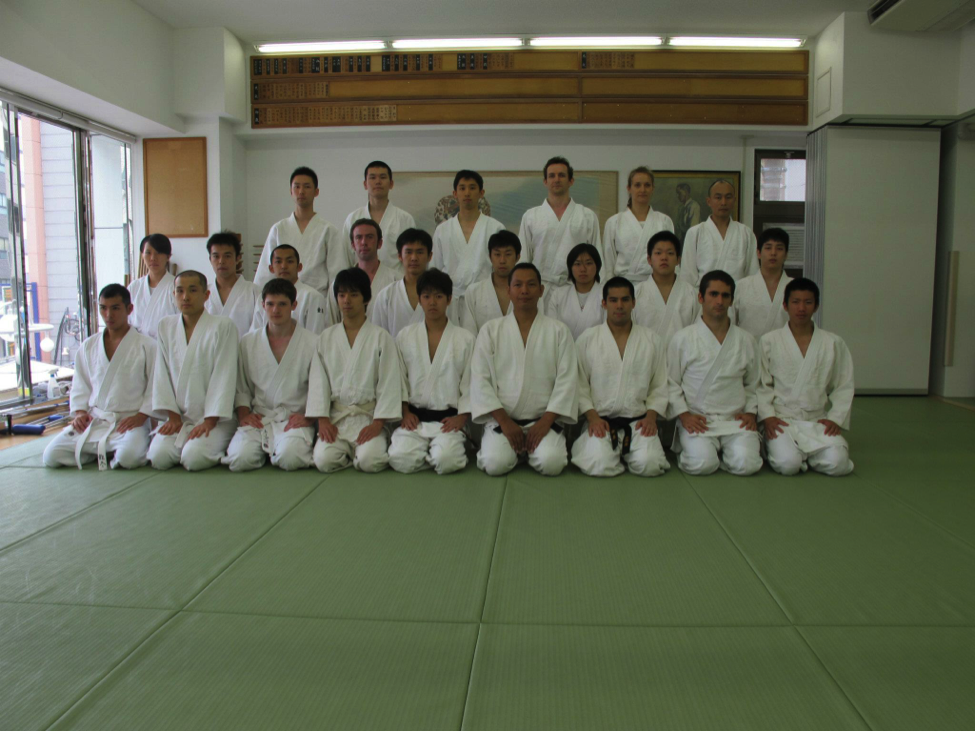
Being a senshusei is the equivalent of a full-time job in martial arts and then some. Senshusei show up every day before 7 A.M. and race around the dojo cleaning every inch until it’s time for the first hour’s lesson. Then the daily formal greeting to the administration, in which the senshusei squad leader must, at the top of his lungs, formally announce that all members are present. Then another ninety minutes of training, half an hour to gulp down lunch, and finally another ninety minutes of blood, sweat and – particularly in my case – tears.
Once a crybaby, always a crybaby. The tears came nearly every single class. Anything the class was told to do, I couldn’t do. Movements that I struggled with during my time as a “normal” student became hell since, once I had become a senshusei, I was required to do moves not only correctly, but also at top speed. Any mistakes at all are quickly reprimanded by a scream from the instructor at which point the offender must repeat the technique from the top while the rest of the class waits. As I picked myself up from the mat after falling from the strain of yet another hyperextension exercise, painful memories from my adolescence started forming in my vision. Through the pain in my knees I was somehow aware of my wrestling coach walking away from me, Mr. Swift jeering at me from behind his perfectly groomed goatee, Keanu gloating over my mud-soaked self. Everything was impossible and there was nothing I could do about it. Every day, every hour, I wondered why the dojo didn’t tell me to stop coming. But management never said a word and so I kept showing up. The months passed, and the blood and tears continued.
It was halfway through the course when I found out that there was, indeed, something that I could do, though it was not related to technique or form. Even after six months, I still flailed my way through most basic techniques and even had problems simply standing in the basic stance. Two tests had come and gone, both of which I failed, and my reputation as the weakest link had largely been accepted by my training partners, the foreigners so gung-ho to learn Aikido that they travelled halfway across the world, and the cops who largely accepted my existence on what I can only assume was a Japanese sense of mercy for the underdog. Thankfully there was one thing that I had that no one else in the course could even hope to obtain, but it didn’t come out until the most grueling day of the course.
Tasudori (多数取り) means “taking on multiple attackers.” Aikido places a special importance on being able to deal with multiple opponents and, as a result, nearly all forms of the art incorporate practice sessions involving as many as five attackers all converging on the same defender who must navigate through them, interrupting their flow as s/he nimbly evades and parries. Yoshinkan is no different and requires all practitioners testing for anything higher than a first-degree (lowest) black belt to take on two or at most three opponents at once.
The thing that sets Yoshinkan apart, however, is that the attacks are more-or-less for real. Whereas mainstream Aikido involves attacks that are largely for form and will not do much damage if they connect, participants playing the attacking role in a Yoshinkan test will punch and strike with almost full force. Bruises and blood are not uncommon.
Naturally, the senshusei take this a level further. First, there are four attackers, something which even the highest black belts never have to face. Second, they are armed. One of the attackers holds a wooden dagger and the other a wooden sword. Third, rather than the attacks being more or less for real, they are for real and anyone who happens to connect with the dagger or sword will feel it for at least a week.
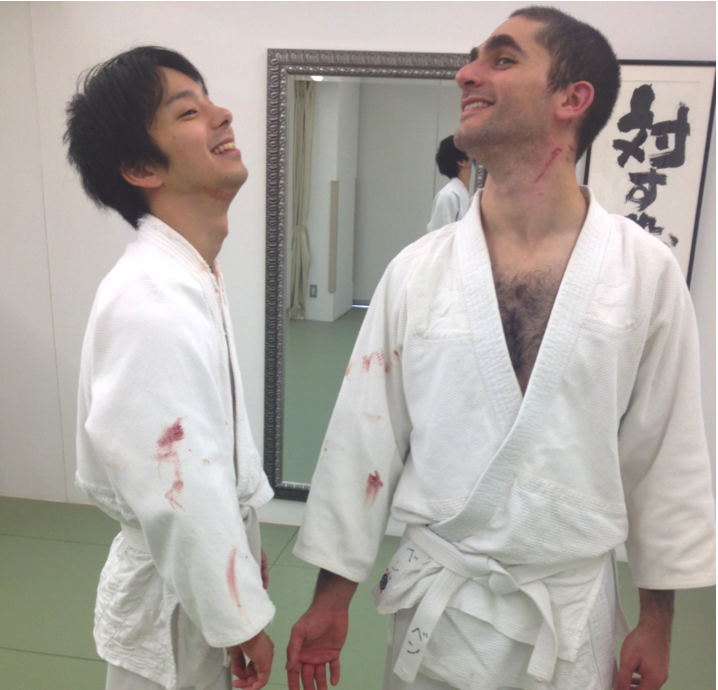
It was in this class in which I finally proved myself useful. I couldn’t do any techniques right and I didn’t have proper balance. My knees had never gotten flexible enough to even do a proper seiza. But being a good attacker tasudori is less about precision and more about endurance. You must become a meat bag, being hit and hit again, getting up every time as you lunge at the testee another time. And I’ll be damned if I wasn’t the best meat bag in my group.
I’m surprised I hadn’t noticed it earlier. All those years of only being able to see myself as physically weaker than those around me had rendered me unable to see the truth: I was physically bigger than every other senshusei. The Japanese cops may have learned more technically from the training, but going to the dojo every day had put 20 pounds of muscle on me and made me bigger than anyone there. I couldn’t use the muscle properly, my techniques still didn’t work, but that wasn’t my job during tasudori. I didn’t have to be accurate or remember complicated steps. I just had to chase the other senshusei like a man possessed.
How would you feel if you had license to run up to a martial artist, an actual law enforcement professional, and punch him as hard as you could, not needing to fear any sort of violent reprisal? And not just a regular punch either, a full lunge with all of your body weight in it. As someone who had spent his whole life only being on the receiving end of beatings I can say that it felt, well, liberating. All of a sudden, I was the one with the strength. Other people were running away from me. In the real world I would have never wanted to play this role— the last thing I ever wanted to do was become someone else’s Keanu, but this day the dojo required me to. And I was good at it!
For nearly an hour, I ran around punching Japanese policemen again and again, getting thrown and rolling off the ground to run up and punch again, punching so hard and so repeatedly that by the end of the day half the class was covered in my bloody knuckle prints. I had beaten my knuckles into so many uniforms so many times that the bleeding took two weeks to stop. If you look at my right hand today you can still see two pink scars on my knuckles.
The practice ended, like so many others, with the Fieldman telling all of us that we had done it completely wrong. I was told to get up and demonstrate my punching posture to the rest of the class so that the Fieldman could imitate it and show exactly why it was, to return to the beginning of my story, a shitty way of punching. But as I bowed in apology for my imperfect form I hid the biggest grin I had had that year. The Fieldman had used my mistake as a demonstration for the class. This meant I had actually done a good job!
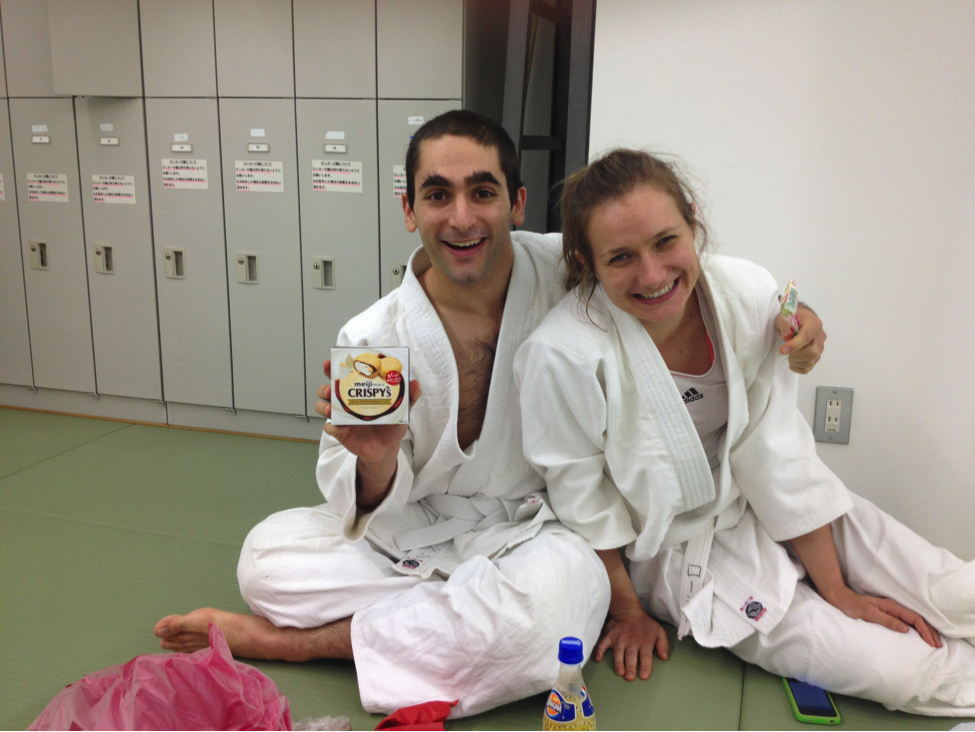
Training ended and after mopping up the blood from the mats I still couldn’t believe it. Although indirectly, the Fieldman had actually complemented me. It was like being hit by lightning. Dazzled, I had to take my time changing into my street clothes. As the cops changed out of their dogi and into the suits they were required to wear, I overheard a couple of them talking about their new Nintendo 3DS games. One of them mentioned that he was saving up to buy the newest title in the Zelda series.
I began listening closer since they had never talked about video games before. Excited to have found a fellow connoisseur, I turned around and the atmosphere chilled. The policeman who has been talking cut himself off and rushed to finish putting on his belt. The rest of them avoided eye contact as they put on their jackets and shuffled out of the room silently.
Figuring I had made yet another cross-cultural faux pas I blithely continued changing. Then it hit me. The cops were just like me. They liked video games; they just weren’t allowed to talk about them. They were there because of their job so they had to put up a tough act but inside they were no different from I was. I hadn’t realized it because I spent the whole course assuming that I couldn’t do martial arts because I was and always would be a nerd. For all I knew, some of them were thinking the same thing. After all, they had just gotten beaten up by someone bigger than them.
The rest of the course was a blur. We soon reached our next test, which I naturally failed. Then it was time for our performance at the annual winter party, where only a year ago the Fieldman had told about being mentally tough. After the performance, an old man came up to me and explained that he was so happy to see a young American trainee because it reminded him of the time when he was my age and an American named Robert Kennedy came to the dojo. I convinced him to do the technique that had pinned Kennedy’s bodyguard on me. Weeks later we took our instructors exam and all passed.
Finally, the last day of the course came. It was my turn to face the multiple attackers punching me so hard and so properly that their fists bled. Fists pummeled into my sides and the wooden sword came crashing down on my arm, turning it purple. And then – it was over. I got my black-belt and instructing license and woke up the next day trying to figure out what to do now that I had completed my senshusei tenure.
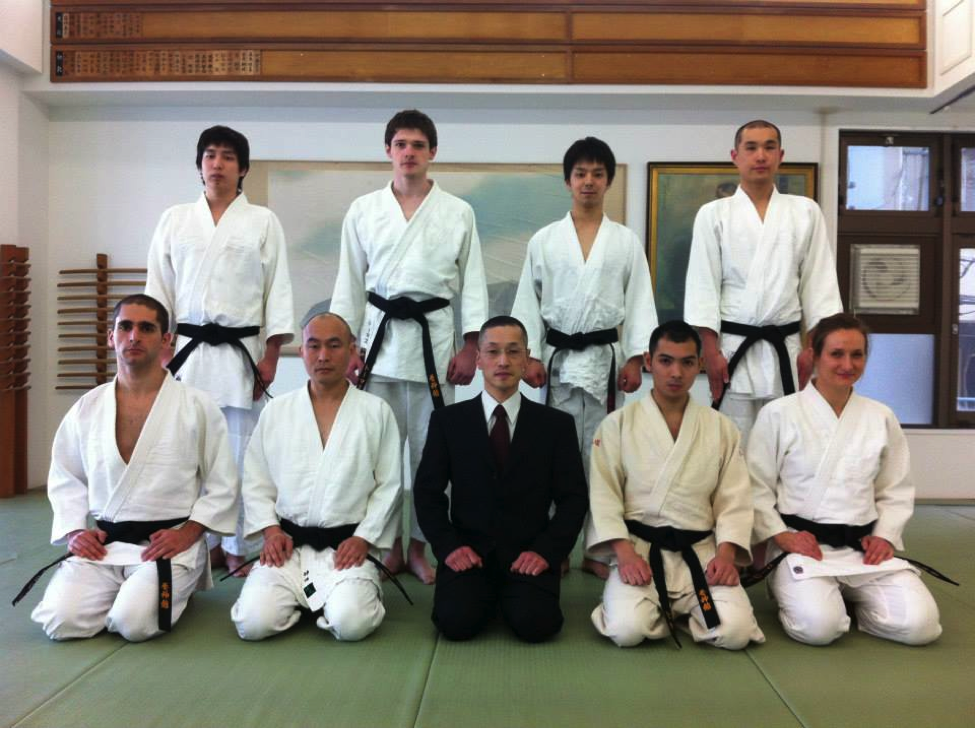
It’s been over a year since I finished my year-long martial arts course and I have now settled into a lifestyle that doesn’t involve getting my butt kicked for hours a day. When I decided to sign up for the course, I had expected things to be different when I finished, but they don’t really feel that way. I still don’t know what I’d do if I found myself in a fight. I still don’t feel like I’m athletically adept.
Of course, even though I don’t feel like things have changed, I can still point to things that actually have. The coolest change is that I can now do flip-breakfalls on a carpeted floor. This is excellent for entertaining children. I’ve also probably gotten better at dealing with stressful situations. Calmness is perhaps the best thing you can learn from a training environment.
Sometimes I wonder how the calmer me would have handled the situations I struggled so much with as a teenager. A little while ago, I decided to look up some of my primary tormentors from my school days. The coaches have aged and the adolescents have somehow transformed into adults. It didn’t take long to find a photo of my old track and field tormentor, Keanu. Back in high school he was tall, handsome and a pretty good athlete, all things I thought were completely out of my reach. Now he’s fat, pimply, and works in an IT office. And the boy who he used to torment is a black belt.
Part of me wants to say that it’s karma that the tables have turned. Keanu was the only person in my life who ever regularly physically roughed me up. Now I could do the same to him if I wanted.
But I don’t. I don’t want to do that. There’s no real use dealing with schadenfreude and besides, Keanu’s not a bad guy. Goodness knows he probably had his own problems. I may have been the originator of some other poor teenager’s high school nightmare. Keanu and I met when we did and I’ll probably never forget what happened then. But neither of us are who we were then. Things change. He’s different now. And so am I.
Sometimes it’s hard to remember I’m not who I was before. I still go to the Yoshinkan dojo and there is a new crop of senshusei who didn’t know me during the course. They only know me as the big foreign black belt and insist on calling me sensei, teacher. I don’t see myself as anything near a teacher-quality model, but they nevertheless compete to be my training partner and ask advice about how to perfect techniques that I myself am still working on. I suppose this is just how things work. My time as a trainee has passed. No matter how much I want to see myself as an inept practitioner, to people who are new, I am nothing other than a seasoned veteran.
It’s a role I’m still new to playing, but, thankfully, I’ve realized that I don’t need to be perfect. A part of me will probably always see myself as a weakling. I’ll certainly never become the best martial artist around. I’ve realized that I don’t need to be perfect to contribute; I just need to be a bit better than I was the day before. Going from a nerd to a black belt didn’t solve all of my problems, but it did help me move on.
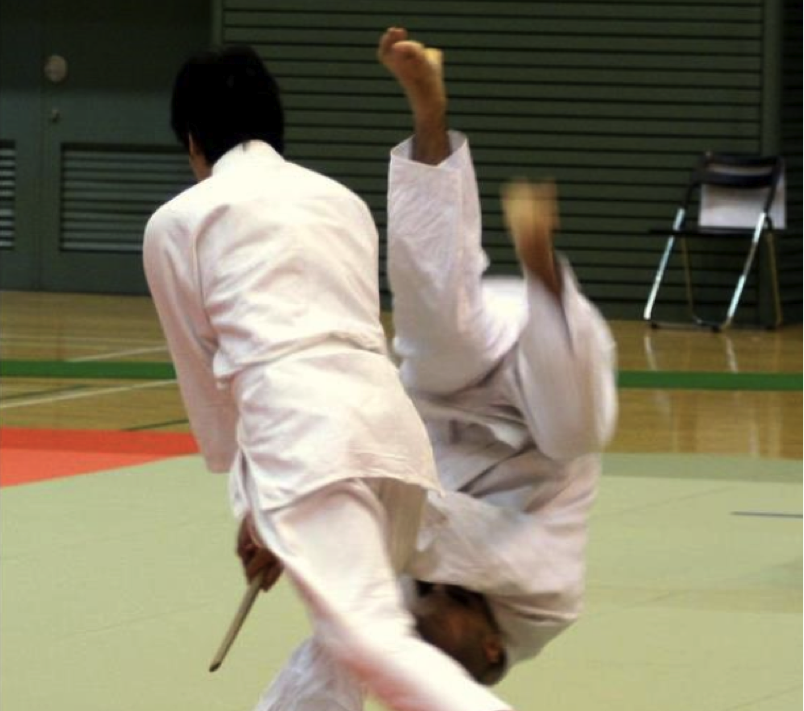
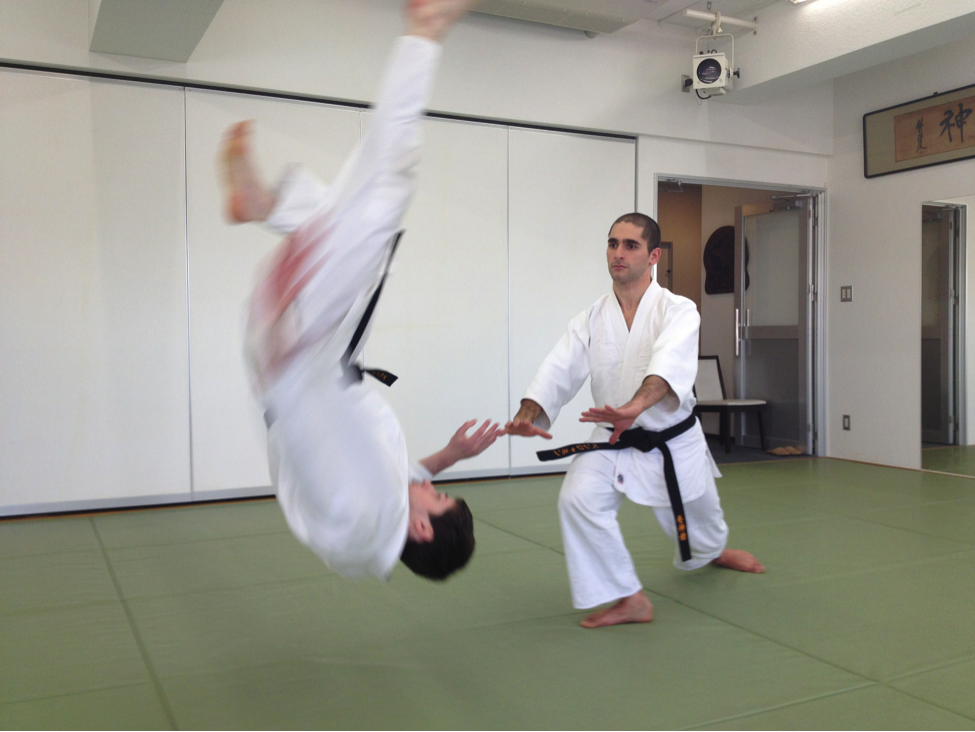
Thanks for the great essay.
Any advice for people who want to go to Japan to study martial arts?
I’ll have to ask Ben to get back to you on that.
Thanks for reading! For anyone who wants to come over here I’d say do it! The language barrier won’t prevent you from being able to train well and there are lots of Aikido places that cater directly to English-speakers. Mugenjuku in Kyoto runs an English-language year-long course and Aikikai’s main dojo is full of foreigners. If you’re committed to training for a year, the dojo will generally help you find a visa.
[…] was arranged so that the belt color became darker as the student advanced in rank, ending with the black belt, the highest level of proficiency. Belts vary according to style and type of martial art. In some […]
Thanks for the insight. I’m looking at doing the senshusei course myself. How many foreign senshusei dropped out and what caused them to? I’m asking so I can more of an understanding of what i’m up against.